Pewter is a silvery metal alloy, a favourite metal of Arts and Crafts metalworkers and jewellers. I have learned from Wikipedia that it is ‘traditionally 85—99% tin, with the remainder consisting of copper, antimony, bismuth and sometimes, less commonly today, lead. Silver is also sometimes used.’ It tarnishes to a dullish grey, and this patinated appearance is often favoured by collectors. If desired, it can be polished to a high silvery shine.
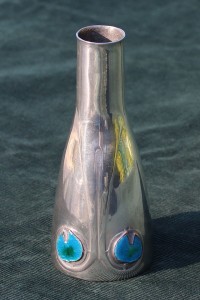
Archibald Knox (designer): Arts and Crafts ‘Tudric’ pewter vase with enamelled medallions, for Liberty & Co. Photo by charlesjsharp.
I have a few pewter objects in my Etsy shop at the moment: three date from the Arts and Crafts period, ie roughly from the 1890s into the early 1900s. and one is very modern, made in the Orkney Islands in the far north of Scotland, but based on a design similar to those of Charles Rennie Mackintosh, one of the most famous Arts and Crafts architects and artists. Originating in the UK, the Arts and Crafts movement put great stead on traditional workmanship, on authenticity and on hand-crafted wares, and on affordable materials—all of which pewter suited perfectly, having been the main metal used for household wares for everyday people for centuries in the UK.
The first piece I listed in my Etsy shop was a shallow Arts and Crafts pewter dish with a flowing fleur-de-lys design. The upper part of the dish is in pewter and it is formed over a white metal base. It would look great as a table centrepiece filled with nuts or tangerines or big bunches of purple grapes—whatever you fancy, really.
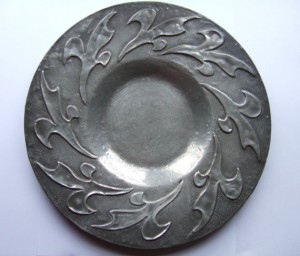
Shallow Arts and Crafts pewter dish with fleur-de-lys decoration. For sale in my Etsy shop. (NOW SOLD).
The second is also an Arts and Crafts piece – it originally would have been a cigarette box but would serve as a lovely jewellery or trinket box today. The pewter has the hand-hammered finish that is so typical of Arts and Crafts work. It has been polished by a previous owner so has more of a silvery shine than the other pewter pieces I have.
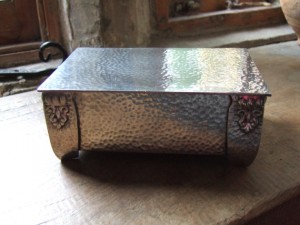
Arts and Crafts hand-hammered pewter jewellery box / cigarette box / trinket box. For sale at my Etsy shop. (NOW SOLD).
The third piece is also a hand-hammered item – a hip flask cunningly shaped to fit the curve of your buttock as it is carried in a back pocket. (I always think it was a bit of that insane Victorian prudery that caused it to be called a hip flask, when a bottom flask would have been a much more appropriate name!) It is marked ‘English pewter’, and originally carried 4 oz of whatever liquid you wanted to fill it with. The piece has had a life, as witnessed by the dints in the soft metal, but I think this is part of its charm. I love a piece that can tell a tale.
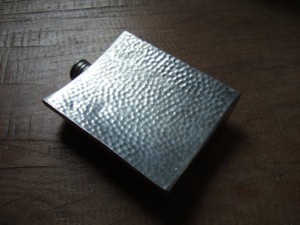
Hand-hammered English pewter hip flask, Arts and Crafts period. For sale in my Etsy shop. (NOW SOLD).
The last pewter piece I have is a modern brooch, in the Arts and Crafts style of famed architect and artist Charles Rennie Mackintosh. It is made by the Ortak company, based in the Orkney Islands off the far north coast of Scotland.
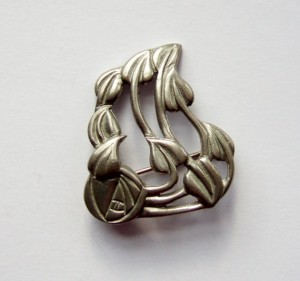
Ortak pewter brooch, in the style of Charles Rennie Mackintosh, and featuring a Glasgow Rose. For sale in my Etsy shop. (NOW SOLD).
It features the famous Glasgow Rose, a stylised rose flower made famous by the artists of the Glasgow School of Art, where Mackintosh trained. After going into administration last year, the Ortak company has been bought by new owners and will be relaunched, with manufacturing resuming in Orkney.